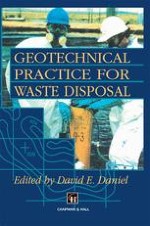Earth scientists and geotechnical engineers are increasingly challenged to solve environmental problems related to waste disposal facilities and cleanup of contaminated sites. The effort has given rise to a new discipline of specialists in the field of environmental geotechnology. To be effective, environmental geotechnologists must not only be armed with the traditional knowledge of fields such as geology and civil engineering, but also be knowledgeable of principles of hydrogeology, chemistry, and biological processes. In addition, the environmental geotechnologist must be completely up to date on the often complex cadre of local and national regulations, must comprehend the often complex legal issues and sometimes mind-boggling financial impli cations of a project, and must be able to communicate effectively with a host of other technical specialists, regulatory officials, attorneys, local land owners, journalists, and others. The field of environmental geo technology will no doubt continue to offer unique challenges. The purpose of this book is to summarize the current state of practice in the field of environmental geotechnology. Part One covers broadly applicable principles such as hydrogeology, geochemistry, and con taminant transport in soil and rock. Part Two describes in detail the underlying principles for design and construction of new waste disposal facilities. Part Three covers techniques for site remediation. Finally, Part Four addresses the methodologies for monitoring. The topics of 'waste disposal' and 'site remediation' are extra ordinarily broad.
